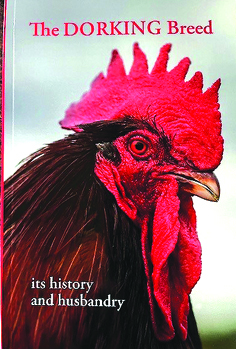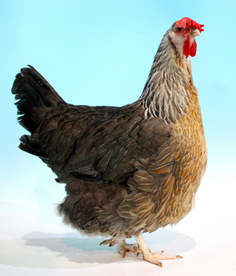Dorking Club The Dorking Breed is one of the oldest British Breeds. There are around 100 members of the Club which are kept in touch with each other by three Newsletters a year, five Regional Shows and the Club Show at the National Championships in autumn or winter annually, plus an annual survey of numbers of the various colours. See below for membership details and some show results on the Standards page. What is a Dorking? Standard colours: silver grey, dark, red, cuckoo, white. Bantam version: yes (1/4 size) in all colours.
History There are two resplendent but silent Dorkings resident in the Dorking Museum and Heritage Centre as a fitting testament to the breed’s antiquity and popularity. The previous representative was a champion bird presented in a glass case in the 1970s by the late Mrs. Margaret Belyavin, energetic Dorking Club Secretary and staunch supporter of the breed, having taken over the running of the Club from Mr. A.J. Major whose bloodlines and those of the Oatey family are found in all the strains available today. The antiquity of the breed, albeit in a different colour, is documented as far back as 30 AD when the Roman writer, Columella, praised a table bird as being square in shape with sturdy short legs, five toes and of a red colour; most of the same characteristics desirable in the modern Dorking, the Romans being credited with bringing the Dorking to this country. Due to the square and meaty body, the Dorking has always been prized for its flesh and eating qualities, including white skin and legs. In the 1860s the speed of growth was an important factor. Whether that speed has now slowed or whether we are blinded by the speed of the broiler is debatable, but flavour and texture have long been valued in the Dorking. Surrey and Sussex have traditionally been the main poultry producing areas for table birds, some being consumed locally and some being sent to London for the discerning gourmets, so the Dorking area has been established as providing first class meat for several centuries. Of the five colours, there is dissension as to which came first, but the Victorian poultry books mention all the colours. The Dorking was used as an ancestor of the Sussex, Orpington and various other breeds in Victorian times. Current position With several colours to choose from, followers of the Dorkings tend to be conservationists with an eye to history, but these large foraging birds are great characters and once kept, seem to stay with a family, producing eggs, meat and fun on the show bench. The Silver Grey is the most numerous, followed by the Red, Dark, White and Cuckoo. Characteristics Unexpectedly, in spite of the low carriage and heavy looks of the Dorking, they are very active and prefer to range widely. With the weights of the adult cocks reaching 12lb (5.4kg) it is understandable that they can suffer from bumble foot, an infection of the pad of the foot usually caused by too hasty a descent from high places. The fifth toe does not seem to serve any useful purpose and is placed just above the fourth toe, pointing upwards, like the letter “k”, but longer than the fourth toe. It is a dominant feature and is present in only four other poultry breeds as standard. Any Dorkings not possessing the distinct fifth toe should not be bred from. Utility aspects The laying capacity of Dorkings is reasonable but tends to be concentrated into the early months of the year. The eggs are a good size and white or tinted in colour. As with most heavy breeds of fowl, the earlier they can be hatched in the year, the more likely they are to attain their correct weight. Lack of size is something which needs monitoring constantly if the breed is to maintain its characteristics. A Dorking matures at about two years and for a stout breed they are fairly long lived: six and seven year old hens are commonplace, but best fertility in the cocks tends to be up to four years. Dorkings have their five toes when they hatch, so any discrepancies can be dealt with at this stage. They are not difficult to rear but do like to range at an early age and appreciate being reared in small batches. They are not an aggressive breed and so may be elbowed off the food by more pushy chicks of other breeds. It is vital to allow them access to good quality feed all the time if they are to attain their correct size. They are hardy if rangeing but can go through a weedy stage if kept in too confined an area, particularly if they have been rangeing. Special requirements High quality feed and plenty of ranging space suits the Dorking best, and they seem susceptible to dusty environments. Membership The Breed Club has been in existence for many decades, the current Secretary (since 1991) is Victoria Roberts. |





